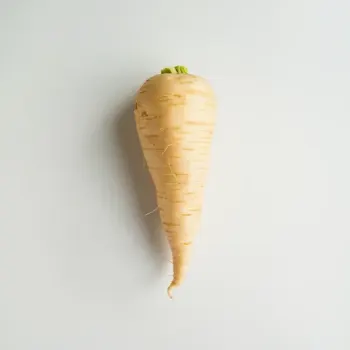Parsnip vs Carrots are root vegetables compared for their use in cooking, each offering unique flavors and textures, from sweet and earthy parsnips ideal for creamy dishes to crunchy, sugary carrots perfect for adding color and sweetness.

Parsnips are a root vegetable closely related to the carrot. They have a cream-colored, slightly tapered shape and offer a sweet, nutty flavor with a hint of earthiness, often intensified by cooking.

Carrots are a popular root vegetable known for their bright orange hue, though they come in a variety of colors. They have a crunchy texture when raw and a sweet, mellow flavor that intensifies with cooking.
Parsnips are generally sweeter than carrots, with a starchier texture that becomes creamy when cooked. Carrots maintain a firmer texture and a sweeter, less earthy flavor. The sweetness of carrots is more sugary, while parsnips have a complex, almost spiced sweetness. Furthermore, parsnips are usually cream-colored, while carrots are most commonly found in orange, but can range in color from purple to white.

Your ultimate Recipe Box, Meal Planner, and Cooking Class all in one
Roasted parsnips caramelize beautifully, creating a rich and tender side dish. Best recipes include herb-roasted parsnips and parsnip fries. Use them to add a creamy sweetness to a roasted vegetable medley. Roasted carrots are a classic side that provide a sweet, caramelized flavor. They are perfect in dishes like honey-glazed carrots or a colorful medley of roasted root vegetables. Carrots hold their shape well and offer a slightly crunchy texture even when cooked.
In soups and stews, parsnips contribute a creamy texture and a depth of flavor. They work exceptionally well in pureed soups such as creamy parsnip soup or as a component in hearty stews. Carrots add color, sweetness, and a touch of freshness to soups and stews. They are a staple in classic recipes like chicken noodle soup, beef stew, and lentil soup.
Parsnips can be used to add moisture and a unique sweetness to baked goods. Try them in spiced parsnip bread or muffins for an unexpected twist. Carrots are famously used in carrot cake, where they provide moisture, sweetness, and a pleasant texture. They're also used in carrot muffins and morning glory bread.
Both parsnips and carrots are nutritious additions to your diet, offering dietary fiber, vitamins, and minerals.
| Nutrient | Carrots ( per 100 grams ) | Parsnip ( per 100 grams ) |
|---|---|---|
| Fat | 0.2g | 0.3g |
| Fiber | 2.8g | 4.9g |
| Sugar | 4.7g | 4.8g |
| Protein | 0.9g | 1.2g |
| Calories | 41 | 75 |
| Carbohydrates | 10g | 18g |
While parsnips can be eaten raw, they are generally better when cooked, which softens their texture and enhances their sweetness.
Both vegetables can be included in a diabetic diet, but portion control is essential due to their carbohydrate content. Carrots have a lower glycemic index and may be the better choice in larger quantities.
Yes, parsnips can substitute for carrots in carrot cake for a similar texture but with a slightly different, spicier flavor profile.
Parsnips contain more fiber per 100 grams than carrots, contributing to digestive health.
Both are excellent for roasting; parsnips become creamy and sweet, while carrots offer a firmer texture and a sweeter taste.